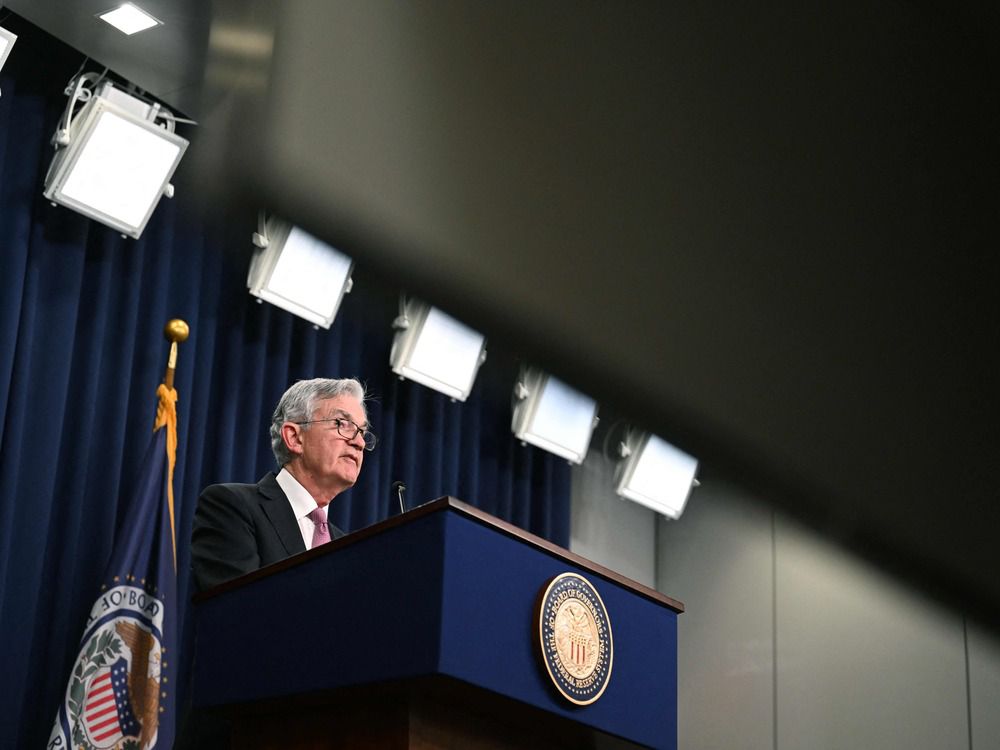Any signs of strength should be seized as an opportunity to offload stocks
Author of the article:
Bloomberg News
Katie Greifeld and Vildana Hajric
U.S. Federal Reserve chairman Jerome Powell. Photo by Jim Watson/AFP via Getty Images Question for market experts: When U.S. stocks staged their biggest rally in two years Wednesday after the Federal Reserve enacted its first half-point rate hike in 22 years, was Jerome Powell happy or sad? And what about today, when the entirety of that advance went poof in 90 minutes?
Advertisement 2 This advertisement has not loaded yet, but your article continues below.
Only he knows, but the question goes to the heart of a puzzle that is likely to be dogging markets for weeks and months to come. How does the motion of markets affect the state of financial conditions, the cross-asset measure of stress that in Powell’s words is the channel via which monetary policy “reaches the real economy?”
The tension is playing out vividly right now. On Wednesday, stocks soared in the biggest Fed-day advance since 2011, ignited when Powell appeared to take the prospect of a 75-basis point hike off the table. But since stocks are a key component of the financial-conditions mosaic, the rally caused constraints on the economy to loosen, something Powell is presumed to disdain. Which brings us to today, when investors rethought the whole thing, pushing the S&P 500 Index down as much as four per cent.
Advertisement 3 This advertisement has not loaded yet, but your article continues below.
The observation that good news can be bad news for asset prices isn’t new. Everyone knows hot economic data is often received poorly in markets, due to its impact on central banks. That dynamic is being taken to absurd lengths right now, when it’s possible to frame the sight of rising stock prices as themselves sending a bearish signal, given their influence on financial conditions.
“We’ve seen this picture before. The Fed has their meeting, Powell talks, and the markets react. Positive or negative, the markets react,” Paul Nolte, portfolio manager at Kingsview Investment Management, said by phone from Chicago. “The next day, the markets tend to undo whatever was done prior. It’s almost as if investors slept on it and decided, ‘Oh, that’s not so bad,’ or ‘Oh my gosh, that’s terrible.”‘
Advertisement 4 This advertisement has not loaded yet, but your article continues below.
The S&P 500’s plunge on Thursday completely erased Wednesday’s surge. Still-expensive technology shares bore the brunt of the selling as Treasury yields took flight, with the Nasdaq 100 sinking as much as 5.4 per cent.
The Fed’s commitment to compressing financial conditions will probably mark the end of the buy-the-dip mentality that has kept a cushion under the pandemic-era equity market. Instead, any signs of strength should be seized as an opportunity to offload stocks, according to Penn Mutual Asset Management’s Zhiwei Ren.
More On This Topic Stocks are tanking with the Dow down more than 1,000 points ‘Inflation is much too high:’ Fed hikes rates half-point, signals more to come The global stagflation shock of 2022: How bad could it get? This advertisement has not loaded yet, but your article continues below.
Article content “You want to sell the rally in this kind of market,” Ren, portfolio manager at the firm, said by phone. “When the Fed tries to ease financial conditions, you want to buy the dip, because they needed to push up equity prices so people can spend more money. Now they want people to spend less money and they want to push down asset prices. So you should sell the rally.”
Thursday’s wipeout in risk assets might spare central bankers a reprise of what happened in March, when U.S. financial conditions eased in the aftermath of the Fed’s 25-basis point kickoff hike, undermining their efforts to dent demand and get a grip on inflation. According to a Bloomberg measure, U.S. financial conditions are currently hovering near the tightest levels since 2018, excluding 2020’s coronavirus shock.
The Fed’s focus on cooling conditions is why 22V Research’s Dennis DeBusschere expects stocks to stay in a tight trading range after a nearly 13 per cent drop in the S&P 500 year-to-date.
“Basically, it comes down to the point of financial conditions can’t ease. If they do, the Fed just gets more hawkish again,” said DeBusschere, the founder of 22V Research. “We have sympathy with that point. It’s basically the main part of the reason we think the market will be violently flat.”
Bloomberg.com
Financial Post Top Stories Sign up to receive the daily top stories from the Financial Post, a division of Postmedia Network Inc.
By clicking on the sign up button you consent to receive the above newsletter from Postmedia Network Inc. You may unsubscribe any time by clicking on the unsubscribe link at the bottom of our emails. Postmedia Network Inc. | 365 Bloor Street East, Toronto, Ontario, M4W 3L4 | 416-383-2300
